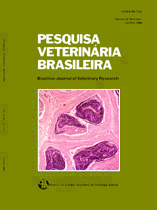 |
|
|
|
Year 2012 - Volume 32, Number 5
|

|
Potential of neural transdifferentiation of mesenchymal stem cells from equine bone marrow, 32(5):444-452
|
ABSTRACT.- Maia L., Landim-Alvarenga F.C., Golim M.A., Sudano M.J., Taffarel M.O., De Vita B., Freitas N.P.P. & Amorim R.M. 2012. [Potential of neural transdifferentiation of mesenchymal stem cells from equine bone marrow.] Potencial de transdiferenciação neural das células-tronco mesenquimais da medula óssea de equino. Pesquisa Veterinária Brasileira 32(5):444-452. Departamento de Clínica Veterinária, Faculdade de Medicina Veterinária e Zootecnia, Universidade Estadual Paulista, Distrito de Rubião Júnior s/n, Botucatu, SP 18618-970, Brazil. E-mail: leandromvet@hotmail.com
The first studies showing the potential of neural transdifferentiation of mesenchymal stem cells (MSCs) from bone marrow (BM) were conducted in camundogos and humans in the early 2000s. After this period, the number of research and publications with the same purpose increased, but with rare or scarce studies in horses. The aim of this study was to evaluate in vitro neuronal transdifferentiation potential of MSCs from equine BM using two protocols: P1 (forksolin and retinoic acid) and P2 (2-βmecarptoetanol). After confirming the mesenchymal lineages, by positivity for the marker CD90 (X=97.94%), negative for the marker CD34 and positive response for osteogenic differentiation, MSCs were subjected to neural transdifferentiation (P1 and P2) for morphological analysis and expression of neural markers GFAP and β3 tubulin by flow cytometry. The results revealed morphological changes in varying degrees between the tested protocols. In protocol 1, twenty four hours after incubation with the media of neural differentiation, a large proportion of cells (>80%) had similar morphology to neural cells, characterized by retraction of cellular body and a large number of cytoplasmic extension (filopodia). However, comparatively, within the first 30 minutes after exposure to the antioxidant β-mercaptoethanol (P2) MSCs showed rapid morphological changes characterized mainly by retraction of cellular body and less cytoplasmic extension. It was also evidenced with the use of this protocol, lower cellular adhesion after exposure to media when compared to P1. Regarding the immunophenotyping analysis it was observed a higher (P<0.001) expression of the markers GFAP and β3 tubulin at the end of P2 compared to P1. The ability of MSCs to generate cell types related to neural lineage is complex and multifactorial, depending not only of inducing agents, but also the environment in which these cells will be cultivated. Thus a greater number of studies are necessary to better understand the process of neural transdifferentiation of MSCs from equine. |
| |
|
|
| |
|
 |